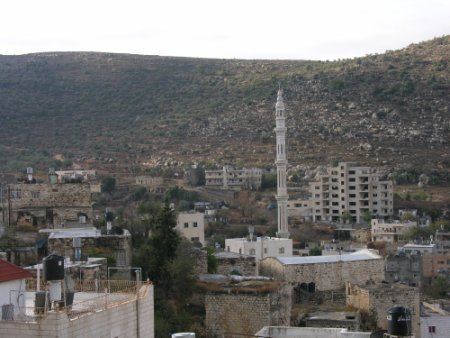Palestine grid 163/145 | ||
 | ||
Name meaning "Spring of the compactly-built one" Weather 12°C, Wind NW at 8 km/h, 84% Humidity | ||
Ein 'Arik (Arabic: عين عريك) is a Palestinian town in the Ramallah and al-Bireh Governorate, located 7 kilometers west of Ramallah in the northern West Bank. According to the Palestinian Central Bureau of Statistics (PCBS), the town had a population of 1,567 inhabitants consisting of Muslims and Christians in 2007.
Contents
Map of Ein Arik
History
Southwest of the village is Khirbet al-Hafi, where Byzantine pottery has been found, together with glass fragments and ancient agricultural terraces. In the Crusader era it was known as Bayt Arif, and already by the mid-eleventh century the village, together with another just north of Jerusalem, belonged to the Jacobite Church. By 1099 the estate was deserted, and was hence annexed by a Crusader, Geoffry of the Tower of David. In 1106, he was imprisoned in Egypt, and his nephew took over the estates. However, the Jacobite Church appealed to Queen Melisende to get their property back. This was finally granted in 1138. Potsherds from the Crusader/Abbasid and early Ottoman period have also been found.
Ottoman era
Ein Arik, like the rest of Palestine, was incorporated into the Ottoman Empire in 1517, and in 1596 'Ain 'Arik appeared in the tax registers as being in the Nahiya of Quds of the Liwa of Quds. It had a total population of 24 households, 14 Muslim and 10 Christian. The villagers paid taxes on wheat, barley, olive trees, vineyards and fruit trees, goats and beehives.
In 1838, Edward Robinson noted it as a Christian village, with 25 Christian men, and the rest Muslims.
In 1870 the French explorer Victor Guérin found Ein 'Arik to have "forty small houses, inhabited by half Muslim, half Greek schismatics, who have a church." An Ottoman village list of about the same year, 1870, showed that Ein 'Arik had 41 houses and with 179 Muslim men, and 24 houses with 80 Greek Christian men; a total of 65 houses with 259 men. The population count included men only.
In 1883, the Palestine Exploration Fund's Survey of Western Palestine described Ain' Arik as "A small stone hamlet in a deep valley with a Greek church, the inhabitants being Greek Christians. There is a good spring to the west with a small stream. The place is surrounded with olives, and there are lemons and other trees round the water in a thick grove."
British Mandate era
In a census conducted in 1922 by the British Mandate authorities, 'Ain 'Arik had a population of 200 Christians and 165 Muslims, while at the time of the 1931 census, 'Ein 'Arik had a population of 220 Christians and 274 Muslims living in a total of 117 houses.
In 1945 the population of 'Ein 'Arik was 610; 360 Muslims and 250 Christians, while the total land area was 5,934 dunams, according to an official land and population survey. Of this, 2,203 were allocated for plantations and irrigable land, 1,168 for cereals, while 32 dunams were classified as built-up areas.
1948-1967
In the wake of the 1948 Arab–Israeli War, and after the 1949 Armistice Agreements, Ein 'Arik came under Jordanian rule.
1967 and aftermath
After the Six-Day War in 1967, Ein 'Arik has been under Israeli occupation.
There are two churches located in the village, one Orthodox Christian and the other one is Roman Catholic Couvent Saint-Etienn. One mosque is located in the center of the village and has the tallest minaret in all of Palestine. Two-thirds of its inhabitants are Palestinian Muslims, and the remaining one-third are Palestinian Christians. The village council which consists of mostly Muslims is chaired by a Christian. Both Christians and Muslims have been living together since early on harmoniously by respecting each other's religion.
Ein 'Arik is known for the natural springs that run through the village and pour into the valley. Both springs, up until the year 2000, were used for drinking and cooking. The village has a large lush valley filled with fruit trees. In 1948 when Palestinians were exiled from their villages some refugees from different villages settled in Ein 'Arik due to the accessibility of clean water.
Ein 'Arik has a public swimming pool, which is open from May to September. There are several restaurants in Ein 'Arik that serve traditional Arabic cuisine, but the most popular of the restaurants is the Falaha, which is very well known throughout the West-Bank area.
